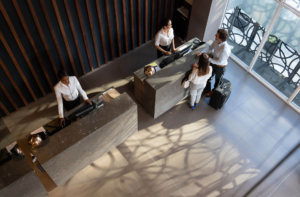Recycling 55,243 Mannequins for a Happier Planet
Recycling 55,243 Mannequins for a Happier Planet
The challenge? Find a way to recycle 55,243 mannequins across the country.
The team? CheckSammy and a client that cared about their impact.
The goal? To reduce carbon emissions and divert metal and plastic from the landfill.
The project? A success!
The Mannequin Project
The average store-life of a mannequin is roughly seven years. After that, it’s typically off to the landfills and in with the newer mannequins. This mannequin replacement process might not seem very harmful, but it’s incredibly taxing on the environment.
CheckSammy was tasked with the near-impossible: Recycle 55,243 mannequins for a nationwide retail chain from multiple independent locations and reduce emissions, and plastic and metal waste.
It’s been one of our most challenging and satisfying projects to date.
First, a closer look at exactly how this project was supposed to be executed.
Execution
Our team had to come up with a sustainable and environmentally friendly solution to recycling 55,243 mannequins for a large retail client. It was no easy feat, by any stretch. CheckSammy looked over various different methods for recycling, such as shredding, source separation, waste to energy, as well as standard recycling options.
By combining these different options across the country, we found that each method was complimentary, and created alternatives to landfilling challenging items.
We focused on meeting the needs of the client and on the logistics behind the company’s end-of-life destinations. The real challenge was dealing with hundreds of locations and making sure that all unusable items ended up in the right places. This was an increasingly difficult task to follow — but we had a plan!
Our team used a Hub and Spoke logistics model to transport all the mannequins from 669 different locations to 121 different staging facilities, where the mannequins would be held, consolidated and prepared to be sent to their final destinations. At the end of it, we used 20 different end destinations for the entire project.
Due to the sheer scale of this project, there were a thousand different moving parts that all had to work together in order for it to be successful.
The beauty of undertaking a project like this is that our team now has the ability to build a blueprint and recreate the same processes for this project and duplicate them for other similar country-wide projects in the future.
The Result
In the end, everything aligned to achieve the desired result for our client. Every single piece of the 55,243 mannequins ended up being recycled, without a single mannequin ending up in a landfill.
The specific results of the project are as follows:
- 164 tons of CO2 reduced
Because we were able to use facilities from across the country, instead of designated landfills, we reduced the amount of carbon being emitted into the atmosphere by over 164 tons. - 54 tons of metal recycled
When you have around 55,243 mannequins on your hands, you’re dealing with a lot of raw materials. While mannequins are mainly plastic, our team was able to recycle their metal skeletons in the process, reducing 54 tons of metal waste. - 170 tons of plastic diverted
The majority of what makes up a mannequin is plastic. During this project, our team was able to reduce approximately 170 tons of plastic waste that would otherwise end up in landfills, inevitably impacting the environment.
Another positive by-product of this project was that we were able to supply the equivalent of about eight homes with electricity for one year.
Waste-To-Energy is the process of generating energy in the form of electricity and/or heat from the confined and controlled burning of waste materials. WTE facilities lessen the amount of solid waste that gets disposed of in a landfill, reducing the need for more and more land. They also reduce methane and CO2 emissions from landfills, contributing to a reduction in global warming (EIA, 2018).
Waste materials used in WTE facilities include:
- Biomass materials like paper, cardboard, food waste, foliage and wood.
- Non-biomass combustible materials like plastics or other materials made from petroleum.
- Noncombustible materials like glass and metals.
Recycling metal and plastics into electricity prevents a tremendous amount of greenhouse gasses being emitted into our atmosphere and recovers valuable natural resources that would have otherwise been lost in landfills.
Throughout this project, our team has kept the environment as our top priority. By working with other environmentally-conscious individuals and organizations across state lines, we’ve been able to reduce the total amount of plastic and metal landfill waste in America by over 220 tons.
To learn more about how we can help support your large-scale sustainability efforts, contact us today.
See Our Services
Create a custom solution to meet your waste and sustainability goals. Contact us today!
Continue reading
Dive deeper into the CheckSammy Blog by reading one of our posts below
Feeling the Pain of Higher Resident Turnover? Apartment Junk Removal Can Help
If you’re a property manager, you’ve probably had a significant increase in tenant turnover over the last couple of years. So it’s no wonder apartment junk removal may be top of mind for you right now. There are several reasons for this shift. For one, the housing market is on fire right now. In 2020 […]
Read MoreSetting Up a Community E-waste Recycling Program
E-waste is the fastest-growing municipal waste stream according to the EPA, yet e-waste recycling isn’t keeping pace. In fact, only 12.5% of all e-waste is recycled, reports the EPA. Starting a community e-waste recycling program is a terrific way to ensure hazardous e-waste, like lithium-ion batteries, doesn’t end up in your community’s landfill. Creating an […]
Read MoreWaste Management’s Role in the Circular Economy
Establishing a waste management program for your business or community is one of the best ways you can contribute to the circular economy. Here’s everything you need to know about waste management’s role in the circular economy (and how to get involved). What Is the Circular Economy? Our current economic model is all about taking […]
Read More5 Reasons to Consider a Textile Recycling Program for Your Organization
Americans sent more than 17 million tons of textiles to landfills in 2018, a volume that is only increasing every year, reports the Environmental Protection Agency. When you think about the fact that it can take over 200 years for textiles to decompose, it’s easy to grasp how large textile waste’s contribution is to the […]
Read More8 Benefits of Environmentally Friendly Power Washing Services
If you’re into maintaining the curb appeal of your business or home, then you’ve probably heard of pressure washing. Pressure cleaning involves using high-pressure water spray to remove grime, mold, dust, paint, mud, and other junk from objects or surfaces. Many people worry that pressure washing isn’t good for the environment, but this couldn’t be […]
Read MoreWhy Our Customers Love Our Full-Service Junk Removal
If you’re looking for full-service junk removal services, you’ve come to the right place. CheckSammy is a one-stop shop for all your junk removal and sustainability needs. From our affordability, simplicity, and unrivaled turnaround times to our innovative sustainability solutions and patented technology and data, it’s clear why some of North America’s biggest companies choose […]
Read MoreTips for a Stress-Free Move From An Eco-Friendly Junk Removal Company
What does an eco-friendly junk removal company know about moving? Quite a lot, actually. Moving can be an especially chaotic time. You have to pack everything up, get rid of unwanted items, clean your property, load everything up, and move your things to your new location. That doesn’t even include the unpacking and resettling period. […]
Read MoreCollege Junk Removal Tips for Student Move-In Day
As the new school year gears up, colleges across the country are looking for ways to clean up their campuses before the new year begins, and many of them want to do so sustainably. College junk removal isn’t easy, though, especially around move-in week—and when trying to do so sustainably. As students move in and […]
Read More8 Items Hospitality Businesses May Not Know They Can Recycle
One hotel guest produces 2.5 pounds of trash every single day. Just a single hotel room produces around one cubic yard of waste each month, which totals 200 gallons of waste per room every month. Most of this waste goes straight to the landfill, even though research shows that up to 60% of it is […]
Read More












